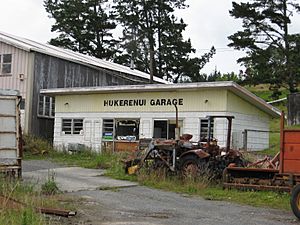Hūkerenui facts for kids
Quick facts for kids
Hūkerenui
|
|
|---|---|

Hukerenui Garage
|
|
| Country | New Zealand |
| Region | Northland Region |
| District | Whangarei District |
| Ward | Hikurangi-Coastal Ward |
| Electorates |
|
| Area | |
| • Total | 22.83 km2 (8.81 sq mi) |
| Population
(2023 Census)
|
|
| • Total | 204 |
| • Density | 8.936/km2 (23.14/sq mi) |
Hūkerenui is a small settlement in the Northland area of New Zealand. It's a place where State Highway 1 passes right through. You can find Kawakawa to its northwest and Hikurangi to its southeast.
The name Hukerenui means "large cascade" in Māori, according to the New Zealand Ministry for Culture and Heritage.
Contents
Discovering Hūkerenui's Past
Early Days and Challenges
Hūkerenui started as Hukerenui South in 1886. A group of local people asked for land under a special settlement plan. The village welcomed its first 25 families the next year. Even though the main road from Whangārei to Kawakawa went through it, it was just a dirt track. This meant it was very hard to travel on, especially in winter.
One of the first ways people earned money was by digging for kauri gum. This was a resin from kauri trees. However, the government stopped these permits after fires in 1888. A flax mill in Towai also offered some jobs. People also worked on building and improving the local roads.
The Railway Arrives
The North Auckland railway line reached Hūkerenui around 1901 or 1902. This was a big step for the area. The railway was later extended north to Towai in 1910 and then to Kawakawa by 1912. This made travel and trade much easier.
In 2019, the official name of the area was changed to Hūkerenui.
Who Lives in Hūkerenui?
Hūkerenui and its surrounding area cover about 22.83 square kilometers. It is part of a larger area called Mangakahia-Hūkerenui.
| Historical population for Hūkerenui and surrounds | ||
|---|---|---|
| Year | Pop. | ±% p.a. |
| 2006 | 189 | — |
| 2013 | 192 | +0.23% |
| 2018 | 195 | +0.31% |
| 2023 | 204 | +0.91% |
In the 2023 New Zealand census, Hūkerenui had 204 people living there. This was a small increase of 9 people since the 2018 census. The average age of people living there was about 39.7 years old.
Most people in Hūkerenui identify as European (Pākehā), and some also identify as Māori. English is spoken by almost everyone. A small number of people were born outside New Zealand.
When it comes to beliefs, many people said they had no religion. Others identified as Christian.
Learning in Hūkerenui
Hukerenui School Years 1–8 is a school for students from year 1 to year 8. It has a roll of 168 students. The school first opened in 1889. Over the years, it combined with other small schools. In 1949, it moved to a new location.
In 1975, Hukerenui School moved again. This time, it went to the site of the old Hukerenui District High School. The school changed its name in 1997 to "Hukerenui School Years 1–8".
For a while, the school also had a secondary department. This department eventually became its own school, the Hukerenui District High School. It operated from 1957 until 1972.
Notable People
- Jim Lynch (born 1947) is a conservationist and cartoonist. He grew up in Hūkerenui.

